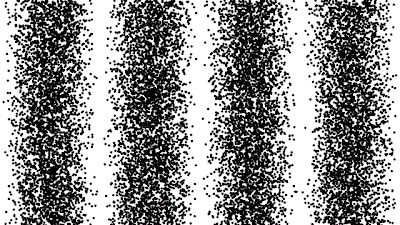 |
| Example of a double slit experiment, by Timm Weitkamp, CC-BY-3.0-de. SOURCE. |
Since the 1600s, scientists tried to figure out whether light, a type of electromagnetic radiation, came in waves or was made up of particles. Christiaan Huygens developed a wave theory (also suggesting that there was a luminiferous ether through which waves traveled, since it was generally thought waves needed a medium) and Isaac Newton a particle (or corpuscular) theory. It wasn't until the 1800s with Thomas Young's double-slit experiment and the buildup of other evidence pointing toward the fact light acted like a wave that Newton's theory was overturned. At least until the Michelson-Morley Experiment, which tried and failed to find any ether.
There are six major types of light phenomenon: reflection, refraction, interference, diffraction, polarization, and the photoelectric effect, all of which can be explained by wave theory, except for the photoelectric effect. Then Albert Einstein published a paper that explained it (introducing photons as continuous waves in 1905), wave-particle duality was also proved to take place with matter by Louis de Broglie (who was awarded the Novel Prize in 1929), and Niels Bohr proposed that light could take on either wave or particle characteristics. Hence, with no other explanation, duality was accepted as reality.
 |
| Example of an interference pattern, by Thierry Dugnolle, public domain image. SOURCE. |
No notable scientist today. Quantum physics is far from stagnant, of course, but I don't know of any wave-particle dualicists. But if you'd like a simulated ripple tank to play around with that has an example of the double-slit experiment (just make sure you have Java):
http://www.falstad.com/ripple/ex-2slit.html
**********
Sources:
http://www.britannica.com/EBchecked/topic/637889/wave-particle-duality
http://www.colorado.edu/physics/2000/schroedinger/two-slit3.html
http://hyperphysics.phy-astr.gsu.edu/hbase/mod1.html
http://library.thinkquest.org/28383/nowe_teksty/htmla/2_10a.html
http://micro.magnet.fsu.edu/primer/java/interference/doubleslit/
http://physics.about.com/od/lightoptics/a/doubleslit.htm
http://physics.about.com/od/lightoptics/a/waveparticle.htm
http://science.howstuffworks.com/light6.htm
http://www.supraconductivite.fr/en/index.php?p=supra-quantique-dual
http://www.thefreedictionary.com/wave-particle+duality
http://www.upscale.utoronto.ca/PVB/Harrison/DoubleSlit/DoubleSlit.html
**********
Do you think any other strange properties such as wave-particle duality will be discovered?-----The Golden Eagle





0 Yorumlar